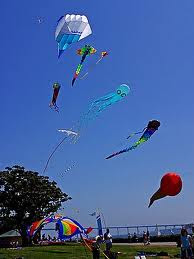A kite is a tethered aircraft.The necessary lift that makes the kite wing fly is generated when air (or in some cases water)flows over and under the kite's wing, producing low pressure above the wing and high pressure below it. This deflection also generates horizontal drag along the direction of the wind. The resultant force vector from the lift and drag force components is opposed by the tension of the one or more lines or tethers.The anchor point of the kite line may be static or moving (e.g., the towing of a kite by a running person, boat, or vehicle).
Kites are usually heavier-than-air, but there is a second category of lighter-than-air kite called a kytoon which may be filled with hydrogen, hot air, methane, or helium; these stay aloft with or without wind; at calm they float; at wind they receive lift from buoyancy and aerodynamic lift. Kytoons have been made in toy-scale as well as military large scale. Kites may be flown for recreation, art or other practical uses. Sport kites can be flown in aerial ballet, sometimes as part of a competition. Power kites are multi-line steerable kites designed to generate large forces which can be used to power activities such as kite surfing, kite landboarding, kite fishing, kite buggying and a new trend snow kiting. Kites towed behind boats can lift passengers which has had useful military applications in the past.
Kites are usually heavier-than-air, but there is a second category of lighter-than-air kite called a kytoon which may be filled with hydrogen, hot air, methane, or helium; these stay aloft with or without wind; at calm they float; at wind they receive lift from buoyancy and aerodynamic lift. Kytoons have been made in toy-scale as well as military large scale. Kites may be flown for recreation, art or other practical uses. Sport kites can be flown in aerial ballet, sometimes as part of a competition. Power kites are multi-line steerable kites designed to generate large forces which can be used to power activities such as kite surfing, kite landboarding, kite fishing, kite buggying and a new trend snow kiting. Kites towed behind boats can lift passengers which has had useful military applications in the past.






















